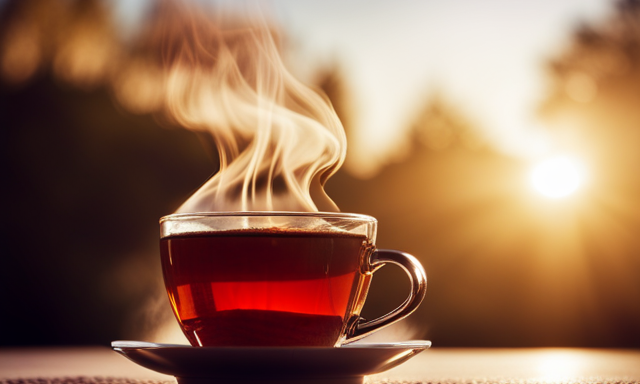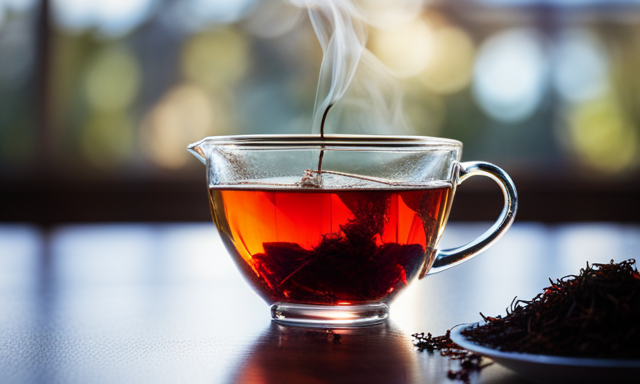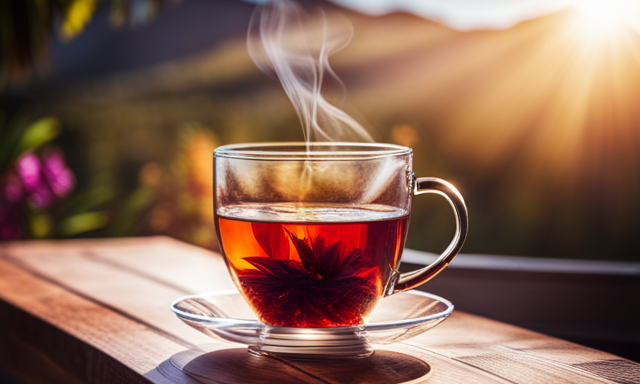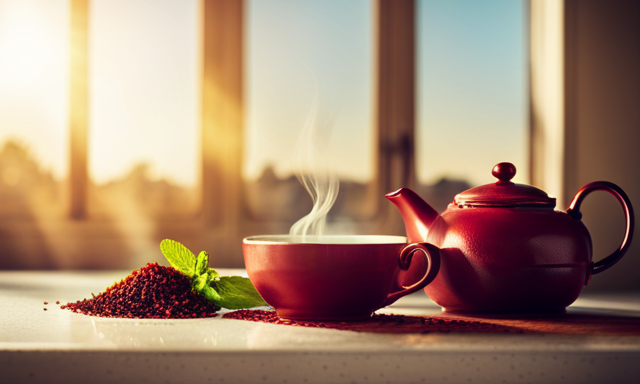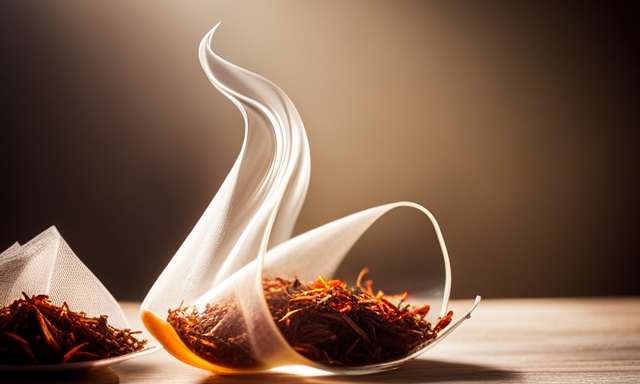Hey there tea enthusiasts! Are you a fan of rooibos tea and wondering what temperature is best for brewing this delicious beverage? Well, you’ve come to the right place! In this article, I’m going to dive into the world of rooibos tea and explore the ideal temperature for brewing it to perfection.
But first, let’s take a quick trip back in time. Did you know that rooibos tea has been enjoyed for centuries in South Africa? Its unique flavor and health benefits have made it a beloved drink around the world.
Now, let’s get back to the present and focus on unlocking the secrets of brewing the perfect cup of rooibos tea.
Understanding the importance of water temperature in tea brewing is crucial. It can greatly impact the taste and overall experience of your cuppa. So, join me as we explore the recommended temperature range for brewing rooibos tea, how to achieve the perfect brewing temperature, and even how different temperatures can enhance the flavor.
Get ready to elevate your rooibos tea game!
Key Takeaways
- Water temperature is crucial for brewing rooibos tea
- The optimal temperature range for brewing rooibos tea is 195°F to 212°F (90°C to 100°C)
- Factors such as water quality, steeping time, and personal preference can affect the brewing temperature
- Achieving the right temperature enhances the flavor extraction without bitterness and ensures a rich and flavorful cup of rooibos tea.
A Brief History of Rooibos Tea
Get ready to be captivated by the fascinating history of rooibos tea and its journey to becoming a beloved beverage.
Rooibos tea, also known as red bush tea, originates from the Cederberg region of South Africa. This unique herbal tea is cultivated from the Aspalathus linearis plant, which thrives in the sandy soil and Mediterranean climate of the area.
The cultivation of rooibos tea has a long and storied history, with the indigenous Khoisan people being the first to discover its natural health benefits. Traditionally, rooibos tea was used by the Khoisan as a remedy for various ailments.
Today, scientific research has revealed that rooibos tea is packed with antioxidants, vitamins, and minerals, making it a healthy choice for tea enthusiasts.
Understanding the flavor profile of rooibos tea is the next step in appreciating its unique qualities.
Understanding the Flavor Profile of Rooibos Tea
Understanding the flavor profile of rooibos tea is key to fully appreciating its unique taste. Rooibos tea, also known as red bush tea, is loved for its distinct flavor that combines earthiness with a subtle sweetness. Its smooth and full-bodied taste is often described as nutty, with hints of vanilla and caramel. This herbal tea is naturally caffeine-free and packed with antioxidants, making it a popular choice for those seeking a healthy beverage option. Studies suggest that rooibos tea may improve digestion, boost the immune system, and promote relaxation. Its natural sweetness also makes it a great alternative to sugary drinks. Now, let’s explore how the flavor profile of rooibos tea can be affected by water temperature as we delve into the importance of brewing techniques.
The Importance of Water Temperature in Tea Brewing
One crucial factor in brewing tea is the impact that water temperature has on the final flavor profile. Understanding tea oxidation and the role of water quality is essential in achieving the perfect cup.
The temperature at which tea is brewed affects the extraction of flavors and compounds from the tea leaves. When it comes to rooibos tea, a lower water temperature is recommended compared to other types of tea. This is because rooibos tea is less oxidized and has a delicate flavor profile that can easily be overwhelmed by high temperatures.
By using water that is around 195°F (90°C), you can ensure that the flavors of rooibos tea are properly extracted without becoming bitter or astringent.
Transitioning into the subsequent section, let’s now explore the recommended temperature range for brewing rooibos tea.
Recommended Temperature Range for Brewing Rooibos Tea
When it comes to brewing rooibos tea, the recommended temperature range is between 195°F to 212°F (90°C to 100°C). This temperature range allows for the full extraction of flavors from the rooibos leaves, resulting in a rich and aromatic cup of tea.
Factors that can affect the brewing temperature include the freshness of the tea leaves, the amount of tea used, and personal preference.
195°F to 212°F (90°C to 100°C)
To brew a perfect cup of rooibos tea, the temperature should range from 90°C to 100°C (194°F to 212°F). This temperature range is crucial in achieving the optimal flavor and aroma of the tea. The high temperature allows the natural oils and flavors to be released from the tea leaves, resulting in a rich and full-bodied cup of tea. To better understand the importance of temperature in brewing rooibos tea, let’s take a look at the following table:
| Temperature (°C) | Temperature (°F) | Result |
|---|---|---|
| 90 | 194 | Light and delicate flavor |
| 95 | 203 | Balanced flavor and aroma |
| 100 | 212 | Strong and robust flavor |
These temperature ranges provide different taste profiles, allowing you to customize your cup of rooibos tea according to your preferences. Factors affecting brewing temperature include water quality, steeping time, and tea leaf quality. By understanding these factors, you can further enhance your tea brewing experience.
Factors Affecting Brewing Temperature
Factors affecting brewing temperature include water quality, steeping time, and the quality of the tea leaves. These factors can greatly impact the flavor of your brew and should be taken into consideration.
The quality of the water used is crucial, as impurities can alter the flavor.
Steeping time is also important. Brewing at a higher temperature for too long can result in a bitter taste, while a lower temperature may not extract enough flavor.
The quality of the tea leaves themselves can influence the optimal brewing temperature.
It is essential to consider these factors when determining the ideal brewing temperature for your rooibos tea.
Now, let’s explore how to achieve the perfect brewing temperature for the best cup of tea.
How to Achieve the Perfect Brewing Temperature
To achieve the perfect brewing temperature for your rooibos tea, follow these simple steps:
- Use fresh, filtered water to ensure optimal flavor.
- Heat the water to a temperature of 200°F (93°C), just below boiling point.
- If you don’t have a thermometer, bring the water to a rolling boil and then let it cool for a minute before pouring it over the tea leaves.
- Avoid using water that is too hot as it can result in a bitter taste.
- Steep the tea for 5-7 minutes to extract the full flavor and aroma.
Maintaining the right brewing temperature is crucial for achieving optimal flavor in your rooibos tea. However, temperature control is just one aspect of the brewing process.
Now, let’s explore the importance of steeping time and its impact on the taste of rooibos tea.
Steeping Time and Rooibos Tea
Steeping time plays a crucial role in bringing out the rich flavors and aromas of your favorite rooibos blend, ensuring a satisfying and enjoyable tea experience. To achieve the perfect cup of rooibos tea, it is important to follow the recommended steeping techniques.
Rooibos tea is unique in that it does not become bitter or astringent if steeped for longer periods. In fact, steeping rooibos tea for a longer time, around 5-7 minutes, can enhance its flavor profile. This allows the tea leaves to release more of their natural oils and compounds, resulting in a fuller-bodied and more robust cup of tea. Additionally, the longer steeping time can also help maximize the health benefits associated with rooibos tea, such as its high antioxidant content.
Moving on to the factors that can impact the taste of rooibos tea, it is important to consider the quality of the tea leaves and the water temperature used.
Factors that Can Impact the Taste of Rooibos Tea
To truly savor the delightful flavors of your cup, it’s essential to take into account various factors that can affect the taste of your rooibos infusion.
Factors such as water quality, steeping time, and the temperature at which you brew your rooibos tea can all play a role in determining its taste.
The temperature at which you steep your tea is particularly important as it can greatly influence the flavors that are extracted from the leaves. Generally, rooibos tea is best brewed at a temperature of around 200°F (93°C). This temperature allows for the full extraction of the tea’s flavors without causing any bitterness or astringency.
Experimenting with different brewing temperatures can help you find the perfect balance of flavors in your cup.
So, let’s dive into the world of brewing temperatures and discover the unique taste profiles they can unlock.
Experimenting with Different Brewing Temperatures
When it comes to brewing a perfect cup of rooibos tea, there are several factors that can impact its taste. As we discussed earlier, factors like water quality, steeping time, and the amount of tea leaves used can all play a role in the final flavor. However, another important factor to consider is the brewing temperature. Different temperatures can bring out different flavors and aromas in the tea.
In this section, I will be discussing the importance of experimenting with different brewing temperatures and exploring alternative brewing methods. By adjusting the temperature, you can control the strength and intensity of the tea’s flavor. For example, a higher temperature may result in a stronger, more robust taste, while a lower temperature may bring out more delicate and subtle notes.
To help you understand the impact of different temperatures, I have created a table below:
| Temperature (°C) | Flavor Profile |
|---|---|
| 80 | Light and floral |
| 90 | Rich and earthy |
| 100 | Bold and robust |
By experimenting with different brewing temperatures, you can find the perfect balance that suits your taste preferences. In the next section, we will explore techniques for enhancing the flavor of rooibos tea.
Enhancing the Flavor of Rooibos Tea
When it comes to enhancing the flavor of Rooibos tea, there are a couple of key points to consider.
Adding honey or other sweeteners can bring a touch of sweetness to the tea, balancing out any bitterness.
Infusing the tea with fruits or herbs can also add layers of flavor, creating a more complex and enjoyable drinking experience.
Overall, these techniques can help elevate the taste of Rooibos tea and cater to personal preferences.
Adding Honey or Sweeteners
For a burst of sweetness in your cup, try adding a touch of honey or your favorite sweetener to your rooibos tea. This simple addition can elevate the flavor profile of your tea, creating a delightful and satisfying experience.
Not only does honey enhance the taste, but it also adds a natural sweetness that complements the earthy notes of rooibos. Additionally, honey has its own health benefits, such as soothing a sore throat and boosting the immune system.
If you prefer a creamier texture, you can also consider adding a splash of milk to your rooibos tea. The combination of milk and honey creates a luscious and indulgent beverage.
Now, let’s move on to the next section where we explore the art of infusing rooibos tea with fruits or herbs.
Infusing with Fruits or Herbs
To enhance the flavors of your cup, try infusing your rooibos tea with your favorite fruits or herbs. Infusing techniques allow the natural essence of the added ingredients to mingle with the earthy taste of rooibos, creating a unique and refreshing beverage.
You can experiment with various combinations, such as adding slices of citrus fruits like oranges or lemons, or infusing the tea with fragrant herbs like mint or lavender. Not only does this infusing process add a delightful twist to your rooibos tea, but it also brings along additional health benefits. Citrus fruits provide a dose of vitamin C, while herbs like mint offer digestive aid.
So, get creative with your infusions and discover a whole new world of flavors and wellness.
Moving on to serving and enjoying rooibos tea, let’s explore the perfect accompaniments for this delightful beverage.
Serving and Enjoying Rooibos Tea
To fully savor the smooth and soothing flavors of rooibos tea, let the warm embrace of each sip transport you to a tranquil oasis. Serving and enjoying rooibos tea is not just about the taste, but also about the experience. There are various serving techniques that can enhance your enjoyment of this delightful beverage. For a refreshing twist, you can serve it over ice with a slice of lemon or a sprig of mint. If you prefer a warmer option, adding a touch of honey or a splash of milk can bring out the tea’s natural sweetness. Rooibos tea is known for its numerous health benefits, including its high antioxidant content and ability to soothe digestive issues. So sit back, relax, and indulge in the goodness of rooibos tea while reaping its many rewards.
| Sip | Taste | Experience |
|---|---|---|
| Delicate | Smooth | Tranquil |
| Refreshing | Sweet | Relaxing |
| Soothing | Aromatic | Calming |
| Revitalizing | Subtle | Serene |
| Nourishing | Earthy | Harmonious |
Frequently Asked Questions
Can I use boiling water to brew rooibos tea?
No, boiling water should not be used to brew rooibos tea. The ideal water temperature for brewing rooibos tea is around 200°F (93°C). Boiling water can result in a bitter taste and diminish the delicate flavors of the tea.
What is the ideal steeping time for rooibos tea?
The ideal steeping time for rooibos tea is 5-7 minutes. To maximize flavor, use freshly boiled water and a tea infuser. Avoid oversteeping, as it may result in a bitter taste.
Does the temperature of the water affect the health benefits of rooibos tea?
The temperature of the water used to brew rooibos tea can indeed affect its health benefits. Steeping it at too high a temperature may degrade some of the beneficial compounds, so it’s best to use water around 200°F for optimal results.
Can I use cold water to brew rooibos tea?
Absolutely! Rooibos tea can be steeped using hot milk instead of water, creating a creamy and indulgent version. However, brewing it with cold water will result in a milder taste and subtle flavors.
Is it necessary to preheat the teapot or cup before brewing rooibos tea?
Preheating the teapot or cup before brewing rooibos tea is not necessary, but it can enhance the flavor and aroma. Alternatively, you can experiment with different temperature options to find your preferred brewing method.
Conclusion
Well, who knew that something as simple as water temperature could have such an impact on the taste of rooibos tea?
It turns out that finding the perfect brewing temperature is key to unlocking the full flavor profile of this unique tea.
So, whether you prefer it hot or iced, take the time to experiment with different temperatures and discover your preferred taste.
Cheers to a perfectly brewed cup of rooibos tea!

